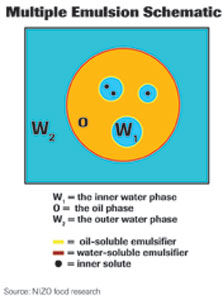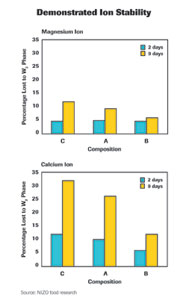June 2011 Prepared Foods – Emulsions are widely present in the daily menu. Examples are dairy products, soups, sauces and even beverages. Multiple emulsions, consisting of small emulsion droplets within emulsion droplets, are promising for new product innovations that will have a positive impact on a product’s texture and on consumer acceptance.

|
| This illustration represents a multiple-phase emulsion, where inner water droplets are surrounded by an oil phase; this, in turn, is a droplet within a continuous outer water phase. |
Innovations in foods are required to meet changing market needs and range from fat reduction, while maintaining good taste, to fortification and healthy ingredient additions. The main challenge the food industry is facing is finding solutions, while maintaining desirable taste and texture. NIZO food research is developing technologies to optimize a food or beverage’s sensory performance, while improving its nutritional value. The formation of multiple emulsions is a powerful new technology that offers solutions. For example, it enables an increased fortification of protein drinks, while keeping the product stable; it can mask bitter healthy compounds; it can reduce fat without compromising on taste or texture; and it can increase juiciness perception.
Simple Emulsions
Emulsion droplet functionality in food varies. The fat these emulsion droplets contain contributes to the nutritional value of the diet. Simultaneously, the fat carries aromas and tastants that affect the perception of foods. Furthermore, emulsion droplets are essential for building specific textures. In cheese, the fat is a structure breaker, resulting in the appreciated softness of the product. In mayonnaise, emulsion droplets are responsible for the high viscosity, which relates to its desired creaminess.
An emulsion consists of at least two immiscible fluids, mostly water and oil, with one fluid dispersed as little droplets within the other fluid that is the continuous phase. The size of the droplets typically ranges between 0.1-100 micrometers. Emulsions are, in principle, unstable and, therefore, will always destabilize into two separate layers of fluid. Various physical-chemical processes drive the instability. The most common mechanisms are coalescence
(merging of the droplets), flocculation, creaming and Ostwald ripening (coarsening of the emulsions, where smaller particles dissolve and are deposited on larger particles). There are several ways to delay or retard the destabilization of emulsions long enough to produce, store and consume the products before apparent separation occurs. One way to stabilize the droplets is the use of emulsifiers that are surface-active agents.
Emulsifiers adsorb at the oil-water interface, forming a protecting layer around the droplets. A second way is to retard the mobility of the droplets by using thickening agents in the continuous phase. This simply lowers the chance for the droplets to touch and also lowers the chance that the droplets will merge. And, finally, the structure of the emulsion droplets, such as the droplet size or the ratio between liquid and solid fat, will impact stability.

|
|
Encapsulation stability of magnesium ions and calcium ions is demonstrated 2 and 9 days after preparation. |
Multiple Emulsions
Emulsion design is used to optimize stability of emulsions under various conditions in food production and storage, including heat treatment, cooling and freezing trajectories, mechanical treatment, changes in pH and ionic strength. Furthermore, emulsion design also is used to optimize the functionality of the emulsions in the food product. Multiple emulsions are one specific group of emulsions with beneficial functionalities. Multiple emulsions, sometimes also called double emulsions, are based on simple emulsions with extra small droplets within the emulsion droplets. In food applications, they primarily are water-in-oil-in-water emulsions (WOW emulsion). (See the illustration “Multiple Emulsion Schematic.”)
A key element is that the inner water droplets (W1 phase) can contain different solutes than the outer water phase (W2 phase). Simultaneously, the oil phase might contain lipophilic compounds. Herein lies the unique possibilities of these types of emulsions for encapsulation. The emulsion droplets can contain both lipophilic and hydrophilic compounds. The delivery of these compounds can be controlled by design of an appropriate adsorbed layer on the emulsion droplets. There can be various triggers for delivery, such as change in pH, dilution, change in temperature or mechanical forces.
Multiple emulsions are more complex in structure than simple emulsions. The destabilizing mechanisms described above for simple emulsions affect not only the oil droplets, but also the inner droplets in the multiple emulsions. This means greater instability exists. However, there are also ways to increase the stability of multiple emulsions. By balancing the osmotic pressure between the inner and outer water phase, the driving force for destabilization is reduced. Furthermore, diffusion of water molecules or solutes from the inner droplets (W1 phase) to the outer water phase (W2 phase) can be lowered by gelling the inner water droplets; by increasing the viscosity of the oil phase; and/or by increasing the thickness and permeability of the adsorbed layers on the interfaces.
A multiple emulsion is generally prepared in two steps (see the illustration “Two Steps of Multiple Emulsion Preparation”). Firstly, a primary emulsion is produced of small water droplets in an oil phase. Secondly, this emulsion is homogenized in the presence of the second water phase. A multiple emulsion can be made in principle with the same equipment as a simple emulsion. The homogenization pressure of the second step needs to be lower than the homogenization pressure in the first step, to diminish the break-up of the primary emulsion droplets.
At NIZO food research, four main benefits of WOW multiple emulsions have been identified for food products:
1. Fortification of protein drinks with increased texture stability.
2. Encapsulation of healthy ingredients with increased masking of off-flavors.
3. Fat reduction without compromising on sensory performance.
4. Water encapsulation for increased juiciness perception.
For example, fortification of protein drinks with essential minerals is desired in special dietary products for infants and the elderly. A limited amount of minerals can be added, because the minerals induce flocculation of the protein matrix, which is not acceptable. By using multiple emulsions, minerals can be shielded from interaction with the protein matrix by loading the inner water droplets with the minerals; this is done while keeping the protein in the outer water phase. In this way, the products remain stable, since interaction of minerals with the protein is no longer possible. Overall concentrations of minerals in the product can be increased, with beneficial nutritional values as a result. (See the images “Increased Stability,” which shows an example of increased stability by using multiple emulsions.)
In a demonstration experiment at NIZO food research’s laboratory, it was shown that it is possible to reduce the migration of magnesium and calcium ions from the inner to the outer water phase by adjusting the composition of the inner water phase (see the charts “Demonstrated Ion Stability”). NIZO believes even further optimization of encapsulation stability can be achieved.
Taste-masking is another potential benefit. Healthy ingredients, such as protein hydrolysates or peptides needed in products for protein-allergic infants, often have an unavoidable, very bitter or bad taste. Loading the inner water droplets with these ingredients significantly reduces the perception of the off-taste. In a test experiment, NIZO found that encapsulation of 70% of the overall concentration of a bitter hydrolysate in a multiple emulsion in a vanilla custard application resulted in a dramatic reduction of the perceived bitterness, when compared to loading the bitter hydrolysates to the outer water phase.
Superior fat-reduced products also can be produced. Fat reduction can be achieved by application of multiple emulsions, in which some of the oil droplets are replaced by water. This replacement with water is not noticed in the sensory perception, when the droplets remain stable upon consumption. This in-mouth stability can be achieved by the type and concentrations of the emulsifiers used. The level of fat reduction reached in this way can be substantial—up to 40%.
The specific design of a multiple emulsion needs to be customized to each application. Issues to be addressed include the specific interactions with the full complexity of the food product; the processing conditions of the full product; and the requirements for delayed or triggered release of constituents.
NIZO food research combines expertise in all the required fields, such as emulsion technology, protein technology, processing expertise, flavor-texture interactions and health expertise, to come to a customized solution for each application. pf
